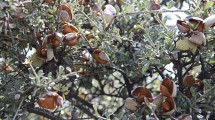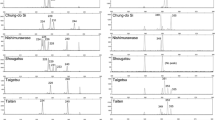Abstract
The S-genotypes of eight almond (Prunus dulcis Miller (D.A. Webb)) cultivars from different geographical origins and of nine new selections from the CEBAS-CSIC (Murcia, Spain) breeding program were determined using single and multiplex PCR with different sets of specific oligonucleotide primers. The results of PCR using the AS1II- and AmyC5R-specific primers showed amplification in a single reaction of 10 different self-incompatibility alleles and of the self-compatibility allele S f. However, the amplified fragments of the S f allele were of similar sizes to those amplified from the S 3 self-incompatibility allele. For this reason, a specific PCR primer CEBASf was designed from the intron sequence of S f. A multiplex-PCR reaction using the AS1II, CEBASf and AmyC5R primers permitted unequivocal identification of the 10 self-incompatibility alleles and of the self-compatibility allele. Multiplex PCR opens the possibility to identify new S-alleles using different sets of primers. The applications of these PCR markers in the almond-breeding programs are discussed.
Similar content being viewed by others
References
Bošković, R., K.R. Tobutt, I. Batlle & H. Duval,1997. Correlation of ribonuclease zymograms and incompatibility genotypes in al-mond. Euphytica97:167-176.
Bošković, R., K.R. Tobutt, I. Batlle, H. Duval, P. Martínez-Gómez & T.M. Gradziel,2003. Stylar ribonucleases in almond: Correlation with, and prediction of incompatibility genotypes. Plant Breed 122:70-76.
Channuntapipat, C., M. Sedgley & G. Collins,2001. Sequences of the cDNAs and genomic DNAs encoding the S1, S7, S8, and Sf alleles from almond, Prunus dulcis. Theor Appl Genet103: 1115-1122.
Channuntapipat, C., M. Wirthensohn, S.A. Ramesh, I. Batlle, P. Arús, M. Sedgley & G. Collins,2003. Identification of incompatibility genotypes in almond using specific primers based on the introns of the S-alleles. Plant Breed122:164-168.
Dicenta, F. & J.E. García,1993. Inheritance of self-compatibility in almond. Heredity70:313-317.
Doyle, J.J. & J.L. Doyle,1987. A rapid isolation procedure for small quantities of fresh leaf tissue. Phytochem Bull19: 11-15.
Godini, A.,1975. Il mandorlo in Puglia: Panorama della situazione varietale. Notiz Ortoflorofrutt 6:10.
Gradziel, T.M. & D.E. Kester,1998. Breeding for self-fertility in California almond cultivars. Acta Hort470:109-117.
Grasselly, C. & G. Olivier,1976. Mise en évidence de quelques types autocompatibles parmi les cultivars d'amandier (P. amygdalus Batsch) de la population des Pouilles. Ann Amélior Plantes26: 107-113.
Grasselly, C., P. Crossa-Raynaud, G. Olivier & H. Gall,1981. Transmission du caractère d'autocompatibilité chez l'amandier (Amygdalus communis). Options Méditerr 1:71-75.
Hall, T.A.,1999. BioEdit: A user-friendly biological sequence alignement editor and analysis program for Windows 95/98/NT. Nucleic Acids Symp Ser41:95-99.
Kester, D.E., T.M. Gradziel & W.C. Micke,1994. Identifying pollen incompatibility groups in California almond cultivars. J Am Soc Hort Sci119:106-109.
Ma, R.C. & M.M. Oliveira,2000. The Rnase PD2 gene of almond (Prunus dulcis) represents an evolutionarily distinct class of S-like Rnases genes. Mol Gen Gent263:925-933.
Ma, R.C. & M.M. Oliveira,2001. Molecular cloning of self-incompatibility genes S1 and S3 from almond (Prunus dulcis cv. Ferragnès). Sex Plant Reprod14:163-167.
Martínez-Gómez, P., E. Ortega, R. Sánchez-Pérez, F. Dicenta, A.M. Dandekar, J.M. Alonso, R. Socias i Company, M. López, I. Batlle & T.M. Gradziel,2003. Identification of self-incompatibility al-leles in almond and related Prunus species using PCR. Acta Hort 622:397-401.
Ortega, E. & F. Dicenta,2003. Inheritance of self-compatibility in almond: Breeding strategies to assure self-compatibility in the progeny. Theor Appl Genet106:904-911.
Reina, A., V. Giorgio & A. Godini,1985. Autres types autocom-patibles parmi la population d'amandiers des Pouilles. Options Méditerr 85(/I):25-29.
Socias i Company, R., D.E. Kester & M.V. Bradley,1976. Effects of temperature and genotype on pollen tube growth of some self-compatible and self-incompatible almond cultivars. J Amer Soc Hort Sci101:490-493.
Socias i Company, R. & A.J. Felipe,1988. Self-compatibility in almond: Transmission and recent advances. Acta Hort224: 307-317.
Tao, R., H. Yamane, H. Sassa, H. Mori, T.M. Gradziel, A.M. Dan-dekar & A. Sugiura,1997. Identification of stylar RNases asso-ciated with gametophytic self-incompatibility in almond (Prunus dulcis). Plant Cell Physiol38:304-311.
Tamura, M., K. Ushijima, H. Sassa, H. Hirano, R. Tao, T.M. Gradziel & A.M. Dandekar,2000. Identification of self-incompatibility genotypes of almond by allele-specific PCR analysis. Theor Appl Genet101:344-349.
Thompson, J.D., T.J. Gibson, F. Plewniak, F. Jeanmougin & D. Hig-gins, 1997. The Clustal X windows interface: Flexible strategies for multiple sequence alignment aided by quality analysis tools. Nucl Acids Res 25(24): 4876-4882.
Ushijima, K., H. Sassa, R. Tao, H. Yamane, A.M. Dandekar, T.M. Gradziel & H. Hirano,1998. Cloning and characterization of cD-NAs of the S-Rnases in almond (Prunus dulcis): Primary struc-tural features and sequence diversity of S-Rnases in Rosaceae. Mol Gen Genet260:261-268.
Author information
Authors and Affiliations
Rights and permissions
About this article
Cite this article
Sánchez-Pérez, R., Dicenta, F. & Martínez-Gómez, P. Identification of S-alleles in almond using multiplex PCR. Euphytica 138, 263–269 (2004). https://doi.org/10.1023/B:EUPH.0000047097.96271.bf
Issue Date:
DOI: https://doi.org/10.1023/B:EUPH.0000047097.96271.bf




